This discovery is the only known example of a mummified pregnant woman.
Technology continues to give us more insights into our past. Researchers at the Warsaw Mummy Project made a very unexpected and rare discovery while examining artifacts at the National Museum of Warsaw with a CT scanner for the first time.
"This is our most important and most significant finding so far, a total surprise," team member Wojciech Ejsmond of the Polish Academy of Sciences told the Associated Press.
What previously was thought to be a mummified Egyptian priest named Hor-Djehuti due to inscriptions on the elaborate burial accouterments, was found to be a mummified Egyptian woman in the late stages of pregnancy, instead. The CT scan images are the first of a mummified pregnant woman and fetus.
"Radiological examination of an ancient mummy said to have been found in royal tombs in Thebes, Upper Egypt, has proved it is the body of a pregnant woman. She came from the elite of Theban community and was carefully mummified, wrapped in fabrics, and equipped with a rich set of amulets. Closer examination has revealed that the woman died between 20 and 30 years of age together with the fetus in age between the 26th and 30th week of the pregnancy. This find is the only known case of an embalmed pregnant individual," the research team wrote in the Journal of Archaeological Science in April.
Researchers now think that the female mummy had been placed in the wrong coffin by 19th-century antiquity dealers, leading to the misidentification. While there is evidence that the mummy had likely been targeted for valuables, at least 15 items remained within the wrappings.
Radiological examination of our mummy, has proved it is the body of a pregnant woman. She came from the elite of Theban community and was carefully mummified, wrapped in fabrics, and equipped with a rich set of amulets. #pregnantmummy pic.twitter.com/jfkLmxo8pi
— Warsaw Mummy Project (@warsaw_mummy) April 29, 2021
In addition to being a first for scientists in this field, the discovery of mother and child has the possibility to advance research into pregnancy and maternity practices in ancient times. It also opens up questions related to the status of a fetus in ancient Egyptian religion and society. In mummies of this time organs were commonly removed, rewrapped, and bundled in the body cavity of the mummy itself, as was the case in this woman; however, the fetus had not been removed like other organs had, as the uterus remained intact, which is how researches first spotted a little foot.
Visitors to the New Gallery of Ancient Art at the National Museum in Warsaw can see this historical find for themselves.
Mum and mummy. You can see our pregnant mummy from Tuesday at the New Gallery of Ancient Art at the National Museum in Warsaw.@Reuters @Muzeum_Narodowe @UniWarszawski @AffideaPolska @AffideaGroup @greygroup @generalelectric @ElsevierST pic.twitter.com/VRjSOQnsF2
— Warsaw Mummy Project (@warsaw_mummy) May 1, 2021
Check out more about the research in the Journal of Archaeological Science or visit warsawmummyproject.com.
What do you think about this discovery? Are you a fan of Egyptian history? Let us know in the comments!
